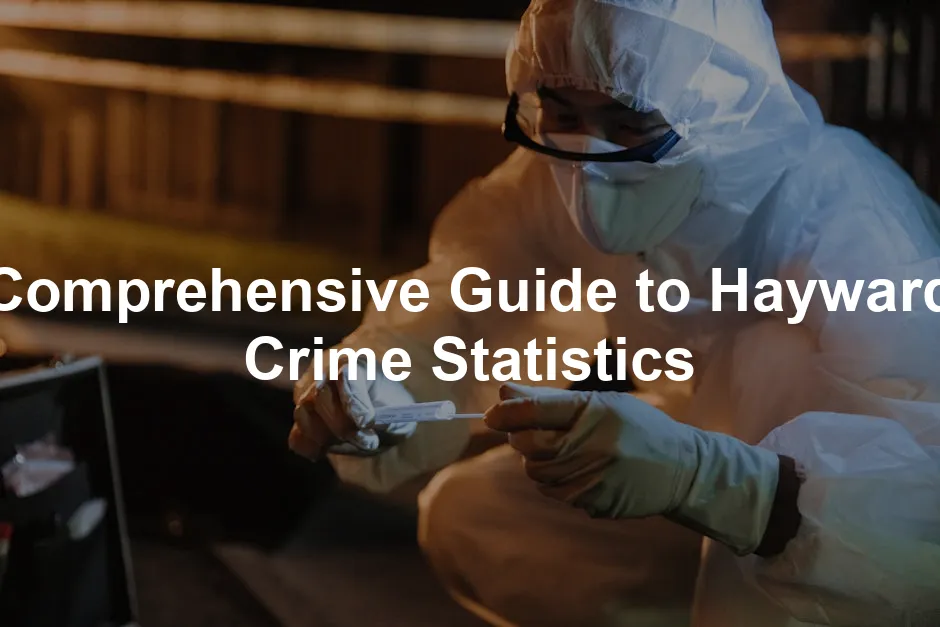Introduction
Nestled in the heart of Alameda County, Hayward, California, is a vibrant city with a population of over 150,000. Its rich diversity and proximity to the San Francisco Bay Area make it an attractive place for families, professionals, and adventurers alike. However, like any urban area, Hayward faces challenges, particularly concerning crime. Understanding crime statistics is crucial for residents, potential movers, and policymakers who want to ensure safety and community well-being.

By understanding Hayward’s crime statistics, residents can make informed decisions about their safety and lifestyle.
Crime statistics provide valuable insights into the safety of a neighborhood. They help residents gauge the risks in their surroundings and empower them to make informed decisions about their safety and lifestyle. For prospective residents, these statistics can be a deciding factor when choosing a new home. Policymakers use this data to allocate resources effectively and implement programs aimed at reducing crime.
The latest data from 2022 reveals some intriguing trends. Hayward’s overall crime rate stands at 34 incidents per 1,000 residents, which is higher than both state and national averages. Recent trends indicate particular concerns around property crime, especially vehicle theft, which has surged in recent years. As we break down these statistics, it’s essential to highlight the ongoing efforts by local law enforcement and community engagement initiatives aimed at addressing these issues. By staying informed about crime statistics, residents can better understand their community’s safety landscape and advocate for necessary changes.
In this guide, we’ll explore the current crime rates, types of crimes prevalent in Hayward, and offer comparisons with state and national averages, giving you a comprehensive view of the safety situation in this bustling city. Stay tuned, because knowing the facts can empower you to take action!
Property Crimes
Hayward, California, has seen a notable rise in property crimes, causing residents to raise their eyebrows and perhaps even lock their doors a little tighter. So, what’s going on with these property crime statistics?
First, let’s break down the numbers. According to the latest data from 2022, Hayward has a property crime rate of 30 incidents per 1,000 residents. This figure reveals that becoming a victim of property crime here is a startling 1 in 33 chance. Residents are especially concerned about three types of property crimes: burglary, theft, and motor vehicle theft.

Burglary incidents have been recorded at 510 for the year, translating to a rate of approximately 3.25 per 1,000 residents. That’s right; a home break-in happens more often than you’d like to think. Theft is even more common, with 2,561 reported incidents, which means an alarming rate of 16.34 thefts per 1,000 residents. Theft can involve anything, even that fancy lawn gnome you thought was safe, so vigilance is key!
But wait—motor vehicle theft is where the numbers get truly concerning. With 1,682 incidents reported, Hayward has one of the highest vehicle theft rates in the nation. That’s a jaw-dropping rate of 10.73 per 1,000 residents. If you thought your car was safe in the driveway, think again! This surge in vehicle thefts is a clear message to residents: don’t leave your keys in the ignition or your car unlocked.
To combat this alarming trend, investing in a Car Steering Wheel Lock can provide an extra layer of security. This simple device acts as a deterrent for thieves, making it harder for them to steal your vehicle. Why take the risk when you can easily safeguard your ride?
Let’s add a sprinkle of historical context. Over the years, Hayward’s property crime statistics have fluctuated, but the last decade has seen a noticeable uptick, particularly in vehicle theft. In 2010, for instance, motor vehicle thefts were at a comparatively lower rate, but the trend has been climbing steadily. This increase may stem from a combination of factors, including economic downturns and changes in policing strategies.

The rise in property crimes, especially vehicle theft, raises questions about safety and community resources. Residents are left pondering what more can be done to combat these crimes. Community policing initiatives, neighborhood watch programs, and increased police visibility are some measures being taken. However, the community must also play its part by staying vigilant and reporting suspicious activities.
In summary, Hayward’s property crime landscape is a mixed bag of alarming statistics and community responses. With vehicle theft on the rise, it’s crucial for residents to be proactive in protecting their property. Awareness, vigilance, and participation in community safety programs can go a long way in decreasing these troubling trends. Remember, a little extra caution today can prevent a headache tomorrow!
Comparison with Nearby Communities
When it comes to crime statistics, Hayward stands out, but how does it measure up against its neighbors? Let’s take a closer look at how Hayward’s crime rates compare to nearby cities like Union City, San Leandro, and Fremont. Spoiler alert: it’s a mixed bag!

Comparing Fremont’s crime statistics with Hayward’s can provide insights into safety in the region.
First up, Union City. With a population nearing 76,000, Union City boasts a violent crime rate of 368.3 per 100,000 residents. That’s higher than Hayward’s rate of 341.6 per 100,000. When it comes to property crime, Union City also sees a significant number, with a staggering 2,284.5 incidents per 100,000 residents. This means that Union City, while not a crime-free paradise, has a slightly lower violent crime rate compared to Hayward but a comparable property crime rate.
Now, let’s switch gears to San Leandro. This city, with approximately 75,477 residents, has a violent crime rate of 502.8 per 100,000 people. Ouch! That’s significantly higher than both Hayward and Union City. Property crime here is even worse, at 4,546.1 incidents per 100,000 residents. If you’re looking for a safe haven, San Leandro may not be at the top of your list.
Lastly, we have Fremont, a city known for its suburban charm. With around 230,000 residents, Fremont has a violent crime rate of just 212.0 per 100,000. Talk about a breath of fresh air! Their property crime rate sits at 1,905.5 incidents per 100,000, which is also lower than Hayward’s. It seems Fremont has really cracked the code on safety, making it a more appealing option for families and individuals seeking a tranquil environment.
So, what drives these differences in crime rates? A few factors come into play. For starters, socioeconomic conditions often correlate with crime levels. Hayward has a higher unemployment rate than Fremont, which can lead to increased property crime as individuals struggle financially. Additionally, population density plays a role. Cities like San Leandro and Union City, with their higher density and urban sprawl, can foster environments more conducive to crime.

Furthermore, community engagement and policing strategies vary among these cities. Fremont, for instance, has a robust community policing initiative that promotes safety through collaboration between law enforcement and residents. On the other hand, Hayward’s police department has been actively implementing similar strategies, but the effectiveness may take time to manifest in the statistics.
In summary, while Hayward’s crime rates are concerning, they are not the worst in the region. Union City and San Leandro present higher rates, while Fremont stands out as a safer alternative. Understanding these comparisons is crucial for residents and potential movers, as they navigate the intricate tapestry of safety in the East Bay area. The key takeaway? Stay informed, be aware of your surroundings, and engage with local safety initiatives to foster a happier and safer community!
Resident Safety Perceptions
When it comes to safety, Hayward residents have a mixed bag of feelings. Community polls reveal a spectrum of perceptions about safety in their neighborhoods. According to a recent survey, 52% of residents feel “pretty safe,” while 31% express some concerns but still consider themselves “somewhat safe.” Only a small fraction, about 3%, feel outright unsafe. This data gives a glimpse into how people interact with their surroundings.

Interestingly, there seems to be a disconnect between reported crime rates and how residents perceive their safety. While Hayward’s crime statistics indicate a higher-than-average rate of property crimes, many residents report feeling secure in their neighborhoods. This discrepancy can stem from various factors, including familiarity with the area and community relationships. If you know your neighbors and have a solid support system, the thought of crime can seem distant.
However, this sense of security can be deceptive. Hayward has a crime rate of 34 incidents per 1,000 residents, which is significantly higher than the national average. With a staggering 1 in 29 chance of becoming a victim of crime, it’s vital for residents to stay aware of their environment. The perceived safety can influence community dynamics significantly. If residents feel safe, they are more likely to engage in local activities, attend community meetings, and look out for one another. Conversely, if fear takes hold, it may lead to isolation and hesitance to participate in community life.
This perceived safety plays a crucial role in shaping community engagement. When residents feel secure, they’re more likely to participate in neighborhood watch programs, support local initiatives, and collaborate with law enforcement. A sense of community can significantly enhance the overall safety net for everyone involved.

In conclusion, understanding these perceptions is essential for fostering a proactive approach to safety in Hayward. While crime statistics provide a clear picture, they shouldn’t overshadow the importance of community bonds. Engaging with neighbors, staying informed about local crime trends, and participating in safety programs can collectively enhance the sense of security that residents crave. After all, a connected community is a safe community!
Conclusion
Awareness of crime statistics in Hayward is more than just numbers; it’s about understanding the safety landscape of the community. The latest data shows a complex reality. While residents may feel a sense of safety, the statistics tell a different story. It’s crucial to bridge this gap through education and active engagement in crime prevention initiatives.

Community involvement is paramount. Residents can play an active role in making Hayward a safer place. Joining neighborhood watch programs, attending community meetings, and reporting suspicious activities can significantly contribute to crime reduction efforts. The more engaged the community, the stronger the safety networks become.
It’s also essential for residents to stay informed. Knowledge is power, especially when it comes to safety. Regularly reviewing crime reports and understanding local trends can help individuals make informed decisions about their daily routines.
For those looking to report crime or suspicious activities, resources like the Hayward Police Department’s website provide valuable information. The “Access Hayward” app is also a handy tool for reporting issues like graffiti or abandoned vehicles directly to local authorities.
Lastly, safety tips are crucial for personal protection. Simple measures, such as locking doors, being aware of surroundings, and not leaving valuables in plain sight, can make a significant difference. Consider investing in a Home Security Camera System to monitor your property and deter potential intruders. It’s a smart move for peace of mind!
In summary, while Hayward’s crime statistics paint a concerning picture, community involvement, awareness, and proactive measures can foster a safer environment. Let’s work together to turn this awareness into action and create a thriving, secure community for all!
FAQs
Please let us know what you think about our content by leaving a comment down below!
Thank you for reading till here 🙂
All images from Pexels




